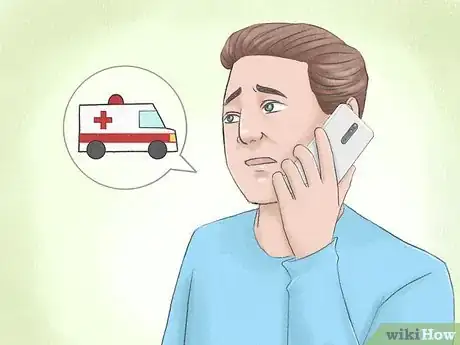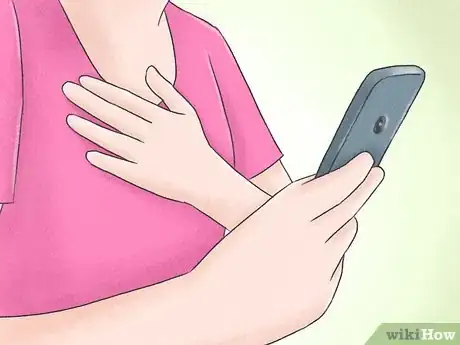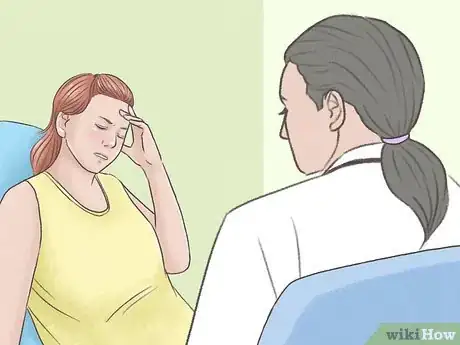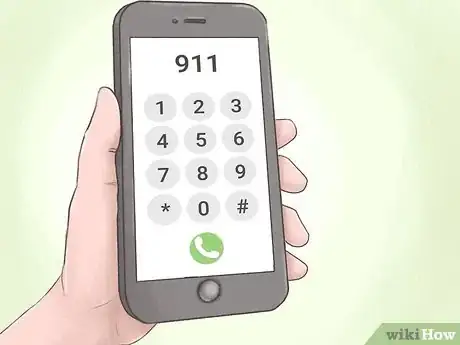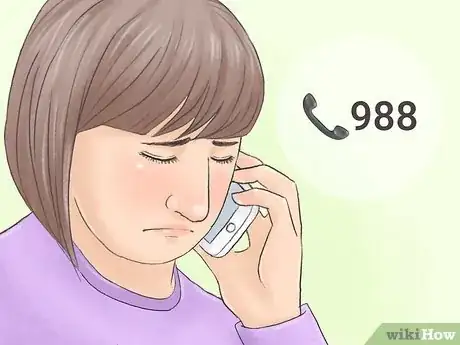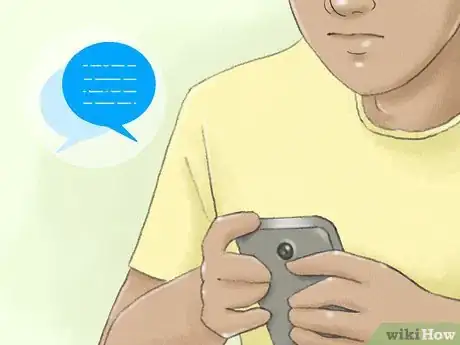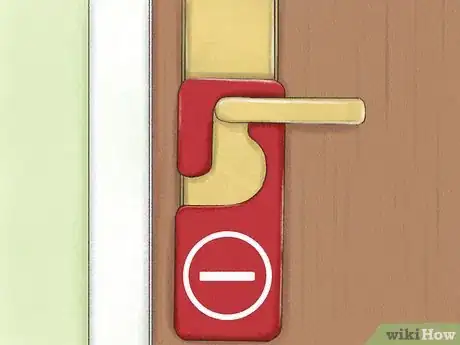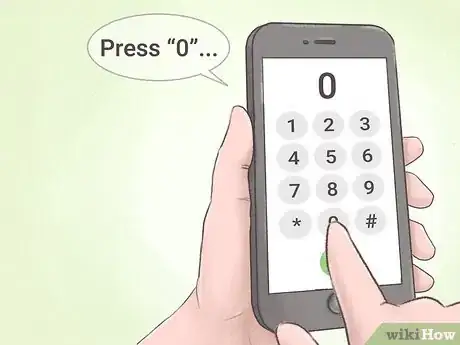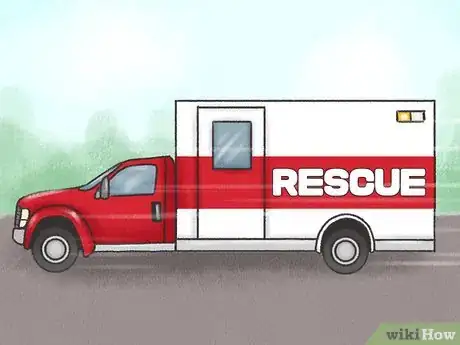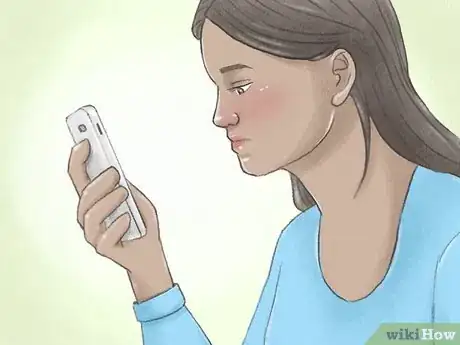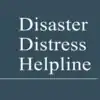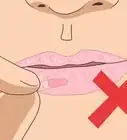This article was co-authored by Disaster Distress Helpline and by wikiHow staff writer, Megaera Lorenz, PhD. The Disaster Distress Helpline, 1-800-985-5990, is a 24/7, 365-day-a-year, national hotline dedicated to providing immediate crisis counseling for people who are experiencing emotional distress related to any natural or human-caused disaster. This toll-free, multilingual, and confidential crisis support service is available to all residents in the United States and its territories. Stress, anxiety, and other depression-like symptoms are common reactions after a disaster. Call 1-800-985-5990 or text TalkWithUs to 66746 to connect with a trained crisis counselor.
There are 15 references cited in this article, which can be found at the bottom of the page.
This article has been viewed 4,651 times.
Crisis hotlines can be a great resource if you’re feeling overwhelmed or if you’re worried about a family member or friend. Calling a crisis line can feel scary, but you can do it! The hardest part is choosing to pick up the phone and make the call. Once you do, a trained counselor will help you talk through your feelings and make a plan to keep yourself or your loved one safe. If you or someone you know is suicidal or in danger of harming themselves, call emergency services or a suicide prevention hotline, such as the 988 Suicide and Crisis Lifeline if you're in the United States, which can be reached by calling or texting 988.[1] Contact your country's suicide prevention hotline if you're outside of the United States.
Steps
Deciding When to Call a Crisis Line
-
1Make the call if you need immediate help for yourself or someone else. The main purpose of a crisis line is to give you quick, short-term help whenever you need it. If you or someone you know needs help right now and you can’t wait to see a counselor or doctor, reach out to a crisis line. No matter when you call, someone will be there to listen and help you through this difficult time.[2]
- Most of the time, you’ll be able to speak to someone within minutes of placing the call or sending a text.
- While most national crisis lines are available 24/7, some local lines might have more limited hours.
-
2Call a crisis line if you feel overwhelmed, alone, or unable to cope. It’s a common myth that you have to be suicidal in order to get help from a crisis line. While crisis lines are a great resource for people who are struggling with suicidal thoughts, they’re also available to people dealing with many other kinds of urgent issues. [3] People often call crisis lines to talk about issues like:[4]
- Relationship problems
- Feelings of depression or sadness
- Loneliness
- Thoughts of self-harm
- Dealing with bullying or abuse
- Body image issues
- Stress related to gender or sexual identity
- Concerns about a friend or family member in crisis
-
3Reach out if you need to talk to someone confidentially. If you’re scared or embarrassed to talk to someone you know about what you’re going through, a crisis line counselor can help. When you make the call or send a text, your connection will be encrypted and is 100% free and confidential, so there’s no identifying information attached. Don’t worry—you don’t have to share your name or any other information about yourself if you don’t want to.[5]
- A counselor might ask you for information like your name and home address so that they can assist you better, but you’re not required to give out that information. You can tell them as much about yourself as you feel comfortable sharing.[6]
-
4Trust your instincts if you’re not sure whether to call. Whether you’re seeking help for yourself, a friend, or a loved one, there’s no simple rule for deciding when it’s time to call a crisis line. Trust your gut and do what feels right. If things feel bad enough that you’re seriously considering calling a crisis line, then it’s probably the right choice.
- Don’t hesitate to call just because you’re worried that your issue isn’t serious enough. If something in your life is causing you enough stress that you’re struggling to cope, it’s worthwhile reaching out for help![7]
-
5Look into counseling for more long-term help. While crisis lines are a great resource to use, they aren’t a good substitute for seeing a mental health professional.[8] If you’re struggling with issues that you think you’ll need more help with going forward, set up an appointment with a therapist you can meet with regularly.
- If you’re worried about being able to afford a mental health professional, a crisis line counselor may be able to help you find free or low-cost mental health resources in your area.
Choosing a Crisis Line
-
1Dial your local emergency number if someone is in immediate danger. If you are afraid for your own life or someone else’s, or if you or someone else has been seriously hurt, don’t hesitate. Call 911 or the number for your local emergency department as soon as you can safely do so.
- In some areas, you can text your local emergency number instead of making a voice call. For example, Text-to-911 is available in some parts of the U.S.[9] However, it’s best to make a voice call if possible, since the dispatcher can get more information that way.
-
2Reach out to a suicide prevention lifeline if you or someone you know is suicidal. If you’re having thoughts of suicide or self-harm, or if you’re worried that someone you know is considering suicide, don’t hesitate. Call a suicide hotline or your local emergency number immediately.[10]
- If you live in the U.S., you can contact the 988 Suicide and Crisis Lifeline by calling or texting 988.[11]
- You can find a list of hotlines by country here: https://www.befrienders.org/.
- If you prefer to reach out by text instead of over the phone, send a message to the Crisis Text Line at 741741 in the U.S. or Canada, 85258 in the U.K., or 086 1800 280 in Ireland.[12]
Keep in mind: You don’t need to be suicidal to call a suicide hotline. The counselors will also talk to you about any other type of crisis you might be dealing with, or they can direct you to someone else who can help.
-
3Look for a crisis line specific to your needs if you have special circumstances. Whether you’re dealing with stress due to a natural disaster or struggling with PTSD related to military service, chances are there’s a crisis line that can help you. Do an online search for a hotline that will serve your needs.[13]
- For example, try doing a search like “LGBTQ youth crisis line” or “domestic abuse hotline.”
Helpful U.S. Crisis Line Numbers:
SAMHSA National Helpline (for substance abuse): 1-800-662-HELP (4357)
988 Suicide and Crisis Lifeline: 988 (you can also text this number)[14]
The National Domestic Violence Hotline: 1-800-799-7233
Disaster Distress Helpline: 1-800-985-5990[15]
The Trevor Project (for LGBTQ youth in crisis): 1-866-488-7386
The Childhelp National Child Abuse Hotline: 1-800-422-4453
Rape, Sexual Assault, Abuse, and Incest National Network (RAINN): 1-800-656-HOPE (4673)
Veterans Crisis Line: 1-800-273-8255, then press 1
-
4Use a text line or online chat service if you’d rather avoid the phone. If the thought of talking to a stranger over the phone makes you anxious, or if you’re not able to talk in private, there are text-based alternatives you can use instead. Visit your crisis line’s website to find out if they have a web-based chat service or a number you can text on your phone. You may even be able to reach out over social media.[16]
Making the Call
-
1Look for a private place to make your call. Calling a crisis line can be really difficult. It takes a lot of courage to reach out and ask for help. If possible, find a place where you can be alone, so you’ll feel safe and have an easier time opening up to the counselor.
- For example, if you have your own room, you might go in and close the door. You can also go out for a walk and make the call from a secluded place, or sit in your car if you have one.
- If you’re not able to get privacy, consider using a text-based crisis line, such as the Crisis Text Line.
-
2Follow any automated prompts to get connected to a counselor. When you call a crisis line, you’ll typically hear an automated message first. You may be given some options to choose from, such as connecting to a line for Spanish speakers or for military service members. Then, you’ll experience a brief hold before being connected to a counselor.[19]
- If you use a text or chat line, you may be asked to write a few words about what sort of crisis you’re dealing with. Within a few minutes, a counselor will come online and start chatting with you.
-
3Give the counselor as much or as little information as you want. Even when you’re chatting anonymously, it can be hard to open up about what you’re going through. You may feel safer or have an easier time discussing your situation if you don’t share a lot of personal details. Or, you might find it more comforting if the person on the other end of the line knows your name and a little bit about you. Share whatever you feel most comfortable with.[20]
- If you’re in immediate danger, the counselor might ask you for your name, address, or other contact information so that they can follow up or send help. However, you’re not obligated to share this information, and crisis line calls very seldom end with emergency services getting involved.
Tip: Don’t worry if you’re not sure what to say at first. If you’re calling a crisis line, chances are you’re extremely upset and distressed. Just say whatever comes naturally to you, even if it’s just “I’m so scared,” or “I just need to talk.” The counselor will help guide you through the conversation.
-
4Work with the counselor to make a plan if you’re in danger. If you’re scared for your own safety or for someone you know, tell the counselor. They’ll help you come up with a solid plan for getting the situation under control, whether it’s calling emergency services, contacting a friend, or finding a place where you can shelter safely.[21]
- In very rare cases, such as situations where a crisis counselor thinks you are in immediate danger and you aren’t able to come up with safety plan, a supervisor might choose to start an “active rescue.” In these situations, the supervisor will contact your local emergency services and send them to help you.[22]
- While a supervisor may access your phone number in case an active rescue becomes necessary, the counselor who talks to you won’t have access to that information unless you give it to them. The supervisor will only look at this information if absolutely necessary.
-
5Agree to a follow-up call if you want someone to check up on you. Some crisis lines, such as the Military Crisis Line, will offer to call back after your initial call to check in and see how you’re doing.[23] If you’d like to have someone call you back, provide your contact information so that they can do so.
- It’s also perfectly okay to say “No” if you’d prefer not to have a call-back!
Warnings
- Always take threats of suicide seriously. If you or someone you know is thinking about suicide or self-harm, reach out for help right away. Call emergency services if you think someone is in immediate danger.[24]⧼thumbs_response⧽
References
- ↑ https://988lifeline.org/
- ↑ https://suicidepreventionlifeline.org/
- ↑ https://suicidepreventionlifeline.org/
- ↑ https://crisistrends.org/
- ↑ https://www.activeminds.org/blog/what-really-happens-when-you-reach-out-to-crisis-lines/
- ↑ https://www.usatoday.com/story/news/2018/09/10/suicide-hotline-national-suicide-prevention-lifeline-what-happens-when-you-call/966151002/
- ↑ https://www.harleytherapy.co.uk/counselling/calling-a-mental-health-crisis-line.htm
- ↑ https://psychcentral.com/lib/common-hotline-phone-numbers/
- ↑ https://www.fcc.gov/consumers/guides/what-you-need-know-about-text-911
- ↑ https://www.nimh.nih.gov/health/topics/suicide-prevention/index.shtml
- ↑ https://988lifeline.org/
- ↑ https://www.crisistextline.org/
- ↑ https://psychcentral.com/lib/common-hotline-phone-numbers/
- ↑ https://988lifeline.org/
- ↑ https://www.samhsa.gov/find-help/disaster-distress-helpline
- ↑ https://www.activeminds.org/blog/what-really-happens-when-you-reach-out-to-crisis-lines/
- ↑ https://988lifeline.org/chat/
- ↑ https://www.crisistextline.org/
- ↑ https://www.activeminds.org/blog/what-really-happens-when-you-reach-out-to-crisis-lines/
- ↑ https://www.usatoday.com/story/news/2018/09/10/suicide-hotline-national-suicide-prevention-lifeline-what-happens-when-you-call/966151002/
- ↑ https://www.usatoday.com/story/news/2018/09/10/suicide-hotline-national-suicide-prevention-lifeline-what-happens-when-you-call/966151002/
- ↑ https://www.crisistextline.org/mental-health/the-tldr-on-suicide-prevention-and-active-rescues-at-crisis-text-line/
- ↑ https://www.af.mil/News/Article-Display/Article/467068/responder-demystifies-calling-military-crisis-line-for-help/
- ↑ https://www.nimh.nih.gov/health/topics/suicide-prevention/index.shtml
